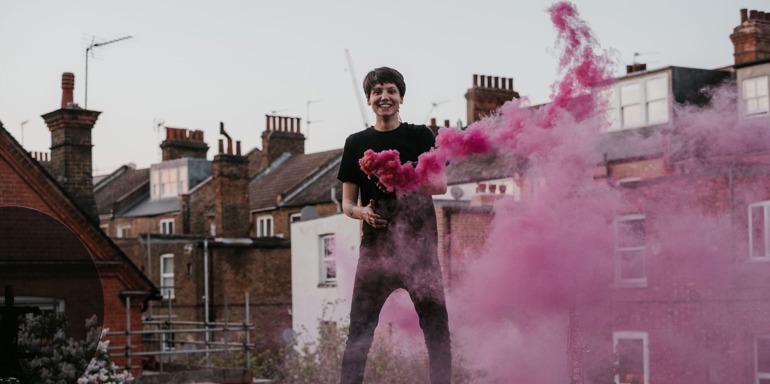Leeds Conservatoire graduate, saxophonist, improviser and composer Lara Jones has been selected as one of four artists, commissioned via the Jerwood Jazz Encounters Fellowship, to create new ways to present jazz at festivals throughout the UK.
Selected alongside pianist Elliot Galvin, saxophonist Faye MacCalman and duo Witch ‘n’ Monk, each artist will participate in the 18-month programme designed to equip artists with the skills required to develop exciting and bold new work. Each fellowship includes R&D funding, in-depth mentoring, a two-day creative lab and specialist support from digital partner The Space.
This announcement comes at a pivotal juncture for Lara, following release of her debut album Ensō, an appearance on BBC Radio 3 and leading online jazz workshops for Jazz North, all within the context of the current lockdown.
We caught up with Lara to find out more about what the Fellowship will involve and discover how Lara’s work responds to the importance of place, soundscapes and noise pollution.
What will the Jerwood Jazz Encounters Fellowship involve?
It’s an 18 month programme that involves experimenting with presenting jazz in unusual spaces and through digital realms. We are currently in the R&D phase in which we select our own mentors to help us develop our ideas and find ways to put them into practice.
Around autumn time we’ll present our work to the partners Manchester Jazz Festival, Cheltenham Jazz Festival, Oxford Contemporary Music and Sage Gateshead and each of the 4 artists will be paired with their festival/venue which will present our work in 2021 as a part of their festival or concert series.
What will the Jerwood Jazz Encounters Fellowship allow you to achieve artistically?
I’ll be developing my solo practice through an audio visual immersive installation in train stations. My idea is to build an AV installation that can be taken to a number of different train stations. The music is composed using saxophone, piano & electronics that creates meditative soundscapes that sync to black and white projections. The audience would walk into a circular space, most likely to be a geodesic dome (a representation of the circular nature of journeys where the beginning often becomes the destination) surrounded by black and white projections that sync with the music.
I hope to give the audience a space to listen to all the sounds around them and begin to notice how their body reacts to these sounds; this will be enhanced through the music and visuals; feeling certain frequencies that make our heart rate speed up and slow down.
How does your work respond to the importance of place, soundscapes and noise pollution?
The installation would aim to induce a meditative or trance like state, which allows people to take time out of their day to relax and reflect. The city is fast-paced and filled with noise, distractions & notifications;
‘Noise pollution is now a world problem. It would seem that the world soundscape has reached an apex of vulgarity in our time, and many experts have predicted universal deafness as the ultimate consequence unless the problem can be brought quickly under control.' (Schafer 1994, 1)
A space to stop, listen and breathe in is needed; this installation will provide that in a location which epitomises a frantic, breathless existence. I am incredibly excited to work with a space where it becomes so intrinsic to the music and audience experience that it couldn't exist without it.

Photo Credit: Jess Rose
When did your interest in site-specific work begin?
It’s hard to pinpoint an exact moment, I think I’ve always been interested in everyday sounds and how we connect and ignore them. The discovery of artists such as Eliane Radigue, Pierre Schaeffer and Pauline Oliveros have definitely had a huge impact though. I think it started becoming more prominent in my work as I was exploring performing music in meditative states and engaging the listener in these states; encouraging the listener to hear the sounds around them as I/others responded to them.
How did your week long residency at Capel Y Graig come about?
I was really fortunate… My partner knew Avi Allen from when she lived in Mid-Wales (where Capel Y Graig is) and was certain we’d get on and that my music would be ideal in this space. She sent some demos I had over to Avi and she got in touch with me. Since then, we have formed a fantastic friendship; we both have similar passions and interests and she invited me to come and complete my album in the space. It was such a blessing because at the time I was really struggling to find a way to get the album recorded but Avi came along and gave me & Ensō a lifeline!
How important was this setting and its relative isolation when creating your album material?
Great question! Incredibly important! This was where a lot of my struggles were coming from when deciding how and where to record the album. Capel Y Graig offered me everything I could ask for in experience and in sound in order to achieve what I wanted with the album.
It was amazing traveling there, we travelled from London and it was SUCH an epic journey and really quite amazing to discover these tiny remote buses that run in these beautiful spots across this part of the world. It was just perfect, mostly it was surrounded by fields and the nearest shop/cafe was a bus ride away! It’s surrounded by nature but also there’s a fairly busy running road just outside which creates beautiful atmospheric sounds inside the most incredible reverb-y space I’ve ever experienced.
Could you tell us a little bit more about the creative process behind your debut album – Ensō?
It all started when I was taking a train journey between Leeds and London regularly to visit my partner (now fiancé!) and the sounds started to become a regular soundtrack to my life. I became fascinated by the sounds and how my body responded to them e.g. faster heart rate at the sound of the train guards whistle etc. and so I started to record the sounds and conversations that took place over the period of time I was taking this journey. The album is built around these field recordings and the emotions of taking a journey to loved ones and how your experience of the sounds changes according to your experience with the people around you… I started to hear the sounds differently when I started to take the same journey but it was to visit my mum who was unwell in hospital.
The work was initially supported by Manchester Jazz Festival by their incredible talent development scheme ‘hothouse’, I created 10 minutes of the music through this scheme alongside a set of visuals that responds and syncs with the music.
You recently appeared on BBC Radio 3 with Corey Mwamba. Do you think northern based jazz artists are receiving a high level of recognition/exposure at the moment?
I think they are and I think that’s because they have to. The North is generating some incredible music, especially in (and around) the jazz sector. I think there has definitely been a shift over the past few years and organisations such as Jazz North, Brighter Sound, all the brilliant UK Jazz Festivals and of course LCoM have made a huge impact on this.
--






